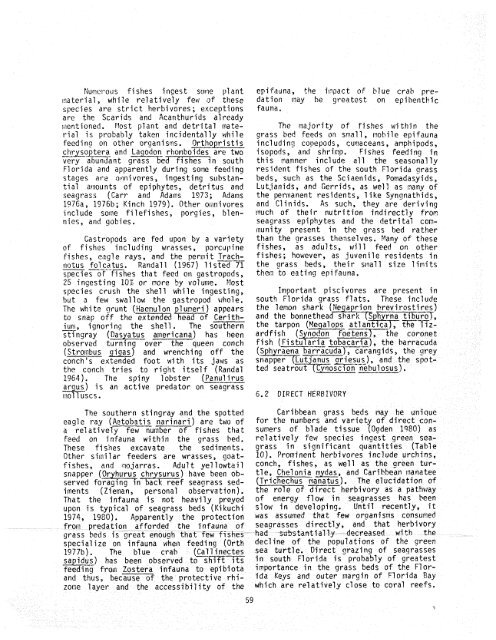The Ecology of the Seagrasses of South Florida - USGS National ...
The Ecology of the Seagrasses of South Florida - USGS National ...
The Ecology of the Seagrasses of South Florida - USGS National ...
Create successful ePaper yourself
Turn your PDF publications into a flip-book with our unique Google optimized e-Paper software.
I\iumcrous fishes ingest sor:e plant<br />
material, while relatively fev~ <strong>of</strong> <strong>the</strong>se<br />
species are strict herbivores ; exceptions<br />
are <strong>the</strong> Scarids and Acanthurids already<br />
l~lentioned. flost plant and detri tal rnaterial<br />
is probably taken incidentally while<br />
feedin9 on o<strong>the</strong>r organisrqs. Ortkopristis -<br />
chrysoptera and Lagodon rko~rlboides are two<br />
very amant grass bed fishes in south<br />
Fl or i da and apparently during sone feeding<br />
stages are oliini vores, ingesting subs tantial<br />
arnounts <strong>of</strong> epiphytes, detritus and<br />
seagrass (Carr and Adam 1373; Adams<br />
1?76a, 1976b; Kinch 1979). O<strong>the</strong>r o~iinivores<br />
include some filefishes, porgies, blennies,<br />
and gobies.<br />
Gastropods are fed upon by a variety<br />
<strong>of</strong> fishes including wrasses, porcupine<br />
fishes, eagle rays, and <strong>the</strong> perr~ii t Trach-<br />
- ~iotus ---- folcatus. Randall (1367) 1 istedx<br />
species <strong>of</strong> fishes that feed on gastropods,<br />
25 ingesting 10% or nore hy volume. !lost<br />
sl~ecies crush <strong>the</strong> shell while ingesting,<br />
but s few swallow <strong>the</strong> gastropod whole.<br />
<strong>The</strong> white grunt (Hacoulon pluveri ) appears<br />
to snap <strong>of</strong>f <strong>the</strong> extended head <strong>of</strong> Ceri thiurri<br />
ignoring <strong>the</strong> shell. Thc sou<strong>the</strong>rn<br />
-9<br />
stingray (Dasyatus arnericana) has been<br />
observed turninq over <strong>the</strong> queen conch<br />
(Strombus --- jigas) and wrenching <strong>of</strong>f <strong>the</strong><br />
conch's extended foot with its .iaws as<br />
<strong>the</strong> conctl tries to right itself -(~andal<br />
1964). <strong>The</strong> spiny lobster (Panul irus<br />
argus) is an active predator on seagrass<br />
1:1oll USCS.<br />
epifauna, <strong>the</strong> ir~gact <strong>of</strong> blue crab predation<br />
may be greatest on epibenttric<br />
fauna.<br />
<strong>The</strong> majority <strong>of</strong> fishes within <strong>the</strong><br />
grass bed feeds on small, ~~obile epifauna<br />
including copepods, cuwaceans, anphi pods,<br />
isopods, and shrimp. Fishes feeding in<br />
this manner include all <strong>the</strong> seasonally<br />
resident fishes <strong>of</strong> <strong>the</strong> south Fl widd crass<br />
beds, such as <strong>the</strong> Sci aenids, Pomadasyids,<br />
Lutjanids, and Gerrids, as well as oany <strong>of</strong><br />
<strong>the</strong> permanent residents, 1 i ke Syngnathids,<br />
and Clinids. As such, <strong>the</strong>y are deriving<br />
!nuch <strong>of</strong> <strong>the</strong>ir nutrition indirectly from<br />
seagrass epiphytes and <strong>the</strong> detri ta1 com-<br />
~iiunity present in <strong>the</strong> grass bed ra<strong>the</strong>r<br />
than <strong>the</strong> grasses <strong>the</strong>mselves. Many <strong>of</strong> <strong>the</strong>se<br />
fishes, as adults, will feed on o<strong>the</strong>r<br />
fishes ; however, as juvenile reside~ts in<br />
<strong>the</strong> grass beds, <strong>the</strong>ir srqall size limits<br />
<strong>the</strong>^:^ to eating epifauna.<br />
Important piscivores are present in<br />
south <strong>Florida</strong> qrass flats. <strong>The</strong>se include<br />
<strong>the</strong> lenon shark<br />
6.2 DIRECT HERBIVORY<br />
<strong>The</strong> sou<strong>the</strong>rn stingray and <strong>the</strong> spotted Caribbean grass beds may be unique<br />
eagle ray (Aetobatis -- narinari) art. two <strong>of</strong> for <strong>the</strong> numbers and variety <strong>of</strong> direct cona<br />
relatively few number <strong>of</strong> fishes that surners <strong>of</strong> blade tissue (Ogden 1980) as<br />
feed on infauna withjn <strong>the</strong> grass bed. relatively feld species ingest greefl sea-<br />
<strong>The</strong>se fishes excavate <strong>the</strong> sediments. grass in significant quantities (Table<br />
O<strong>the</strong>r similar feeders are wrasses, goat- 10). Prominent herbivores include urchins,<br />
fishes, and mojarras. Adult yellowtail conch, fishes, as well as <strong>the</strong> green tursnapper<br />
(Oryhurus chrysurus) have been ob- tle, Chcl onia mydas, and Caribbean manatee<br />
served foraging in bac-f seagrass sed- (Tric-anatus). -- <strong>The</strong> elucidation <strong>of</strong><br />
iments (Zieman, personal observation). <strong>the</strong> role <strong>of</strong> direct herbivory as a pathway<br />
That <strong>the</strong> infauna is not heavily preyed <strong>of</strong> energy flow in seagrasses has been<br />
upon is typical <strong>of</strong> seagrass beds (Kikuchi<br />
1974, 1980). Apparently <strong>the</strong> protection<br />
slow in developing. Until recently, it<br />
was assumed that few organisms consumed<br />
fro~tl predation afforded <strong>the</strong> i nfauna <strong>of</strong><br />
grass beds is great enough that few fishes<br />
seagrasses directly, and that herbivory<br />
had substantially decreased with <strong>the</strong><br />
specialize on infauna wheri feeding (Orth decline <strong>of</strong> <strong>the</strong> ~o~ulations <strong>of</strong> <strong>the</strong> green<br />
1977b). <strong>The</strong> blue crab (Callinectes sea turtle. Direct grazing <strong>of</strong> seaqrasses<br />
sapidus) has been observed toyhift its in south <strong>Florida</strong> is prohaSly <strong>of</strong> greatest<br />
feeding froin Zostera infauna to epibiota importance in <strong>the</strong> grass beds <strong>of</strong> <strong>the</strong> Florand<br />
thus, because <strong>of</strong> <strong>the</strong> protective rhizone<br />
layer and <strong>the</strong> accessibility <strong>of</strong> <strong>the</strong><br />
ida Keys and outer margin <strong>of</strong> <strong>Florida</strong> Bay<br />
which are relatively Close to coral reefs.<br />
59<br />
-3

















